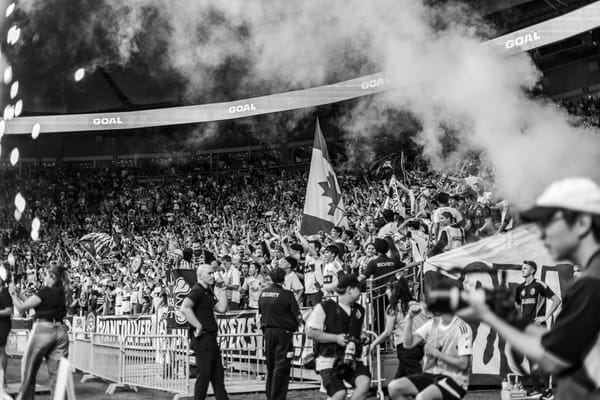The 2025 On-Field Check-In

I didn’t do a “typical” season preview this year. Instead of breaking down the squad, I decided to look at where the Timbers needed to improve on the field. Well, with 6 games left in the regular season, I think it’s time to check in on whether or not they’ve made those improvements. And, since the Summer Three have arrived and the squad make-up is much more different than it was in February, it’s also worth taking the time to see what other areas they need to improve in order to add a second star to their jerseys.
Check-In
2024 Problem 1: Set Pieces
Make no mistake about it: the 2025 Timbers are vastly improved on set piece defense. That’s what the eye test has said. But does the data tell the same story?
Currently, the Timbers have conceded 8 set piece goals from 7.11 dead-ball xGA. By the beginning of August in 2024, Portland had already conceded 12 set piece goals from 8.74 dead-ball xGA. Portland’s dead-ball improvements were magnified last weekend against Minnesota, where they completely shut down the Loons on set pieces. That’s no small feat.
Has there been a tactical change that can be credited towards this improvement? The short answer is no. Portland’s scheme has basically remained the same, but two new starters have boosted their ability to defend the box on dead balls: Finn Surman and Jimer Fory. The Kiwi’s aerial duel win rate is 64.1%, while the Colombian is winning 62.5% of his aerial duels. Dario Zuparic is also chipping in with a 61.9% mark. Oddly enough, Felipe Mora has also been an excellent set piece defender this year. Ditto for Kevin Kelsy. Overall, it’s a teamwide improvement.
Sure, there have been moments where the Timbers look like their 2024 selves on dead balls, but those instances have come when the entire team looks off. Poor set piece defending isn’t Portland’s Achilles heel anymore, but it’s a symptom of a bad performance in general (or, in the case of the Club America game, a dubious red card and a lack of time to adapt).
2024 Problem 2: Defensive Transitions
I’m not wholly convinced that the defensive transition issues have been completely solved. But I’d also be a complete idiot if I didn’t acknowledge that they have been improved. There are two reasons why: tactics and personnel.
Unlike last season, Portland has used two different structures. But whether or not they start in a back three or back four, there’s always 3 players left behind in rest defense. That third player (alongside the center backs) is usually Fory. This is a change from last year, where both fullbacks were encouraged to get forward with regularity. Neville has allowed Fory to pick his spots to bomb up the flanks.
The other tactical change was seen at points in 2024. When the Timbers want to control a game, they will. They’ll put the entirety of their 10 field players in the opposition half and make it impossible to break out. This is the type of play that really suits this team, but it appears at inconsistent times.
In 2024, this style was present when the Timbers were trying to get back into a game. That pattern has largely held firm in 2025. We’ll get to how they can improve that later, but it’s worth noting that the Timbers can do a very good job of forcing teams to play a game on Portland’s terms.
The personnel part of this solution is simply Fory and Finn Surman. I’ve already gone into detail about Fory, but Surman’s elevation to a starting role already improved Portland’s transition defense tenfold. He wins footraces against everybody, and has the best positional discipline on the entire team. He’s always in the right spot to impede an attacker, and it’s the biggest reason why he barely commits a foul. With a lot of elite counterattacking threats in the league, Surman’s dependability and general ability to chase down pacey wingers gives the Timbers the ultimate security blanket.
In addition to the elevations of Fory and Surman, defending as a team has taken a serious step up from last year. Juan Mosquera’s improvements (particularly with recovery runs) should also get some recognition. In each of the past two seasons, his defending has shown a steady progression. He has quietly been one of Portland’s most consistent players in 2025. Defending as a team definitely applies to the forwards, with Antony standing out the most.

This is ludicrous in a good way. Forwards should not be this good at defending. Possessing the urge to defend is step one, but being very good at it is step two. Combine Antony’s output with Surman’s and Mosquera’s recovery runs and you suddenly have a very good transition defense. However, there are still issues here. Like I said earlier, we’ll get to them later. On the whole, there’s been a substantial improvement.
2024 Problem 3: Shots From Distance
In 2024, the Timbers conceded 12 goals from outside the 18-yard box. Let’s take a look at how 2025 is going so far.

Six! That’s progress! Because I am a stickler, I can poke some holes in a few of these. Coello, Giroud, and Suleymanov all scored from free kicks. Giroud’s was a quality strike, Suleymanov’s was the equivalent of David Da Costa’s winner against Austin (in a way, similar but not exactly congruent), and Coello’s can be categorized as a mystifying wall setup decision from James Pantemis. One of these falls into the “worldie” category: Vite. The remaining two were preventable. So let’s break them down.
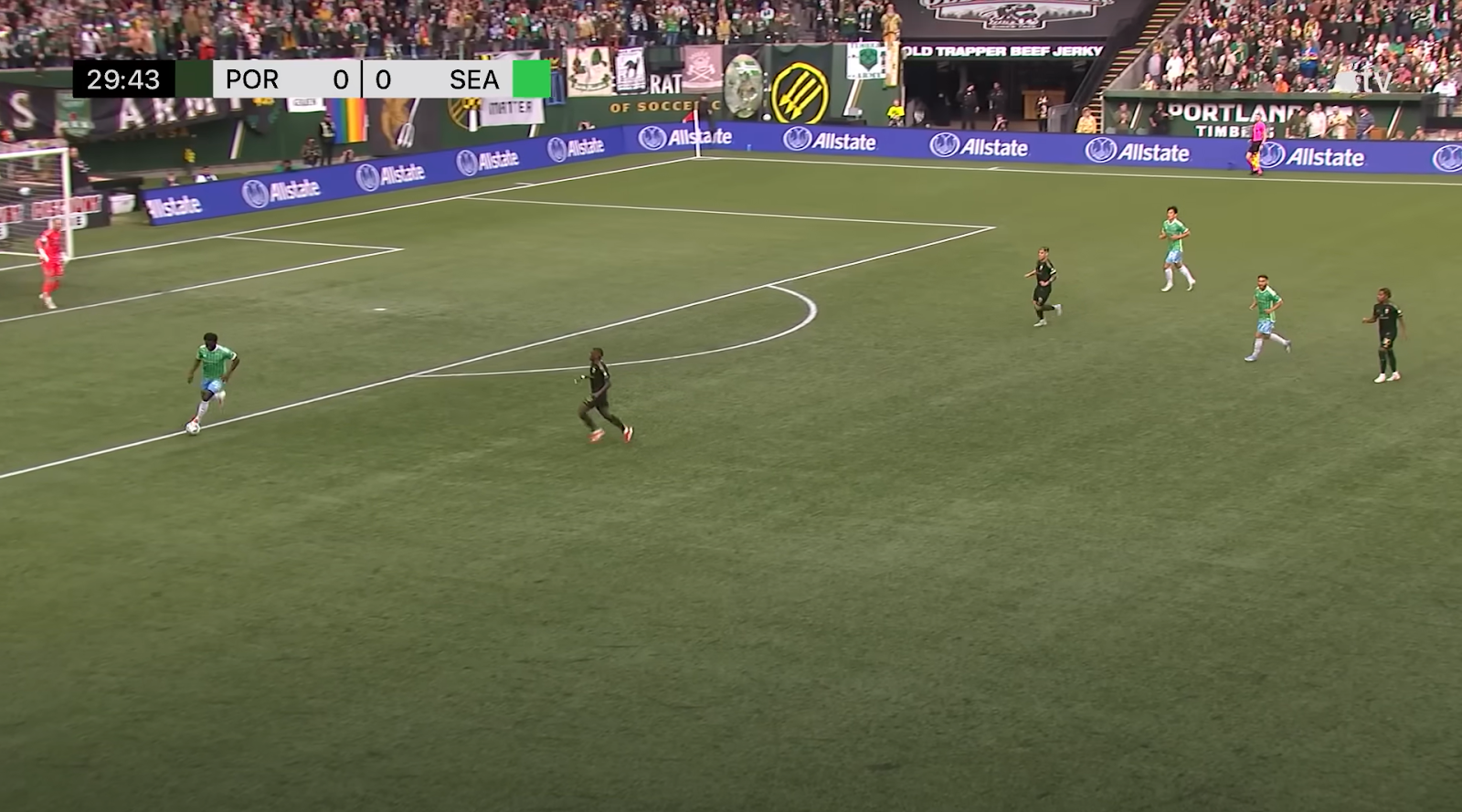
We’re going to start with Rusnak, and we’re going to start at this point in the play. This goal doesn’t entirely fall into the “shots-from-distance” category, and part of this will become important later. Yeimar has the ball, and Da Costa is applying some light pressure.
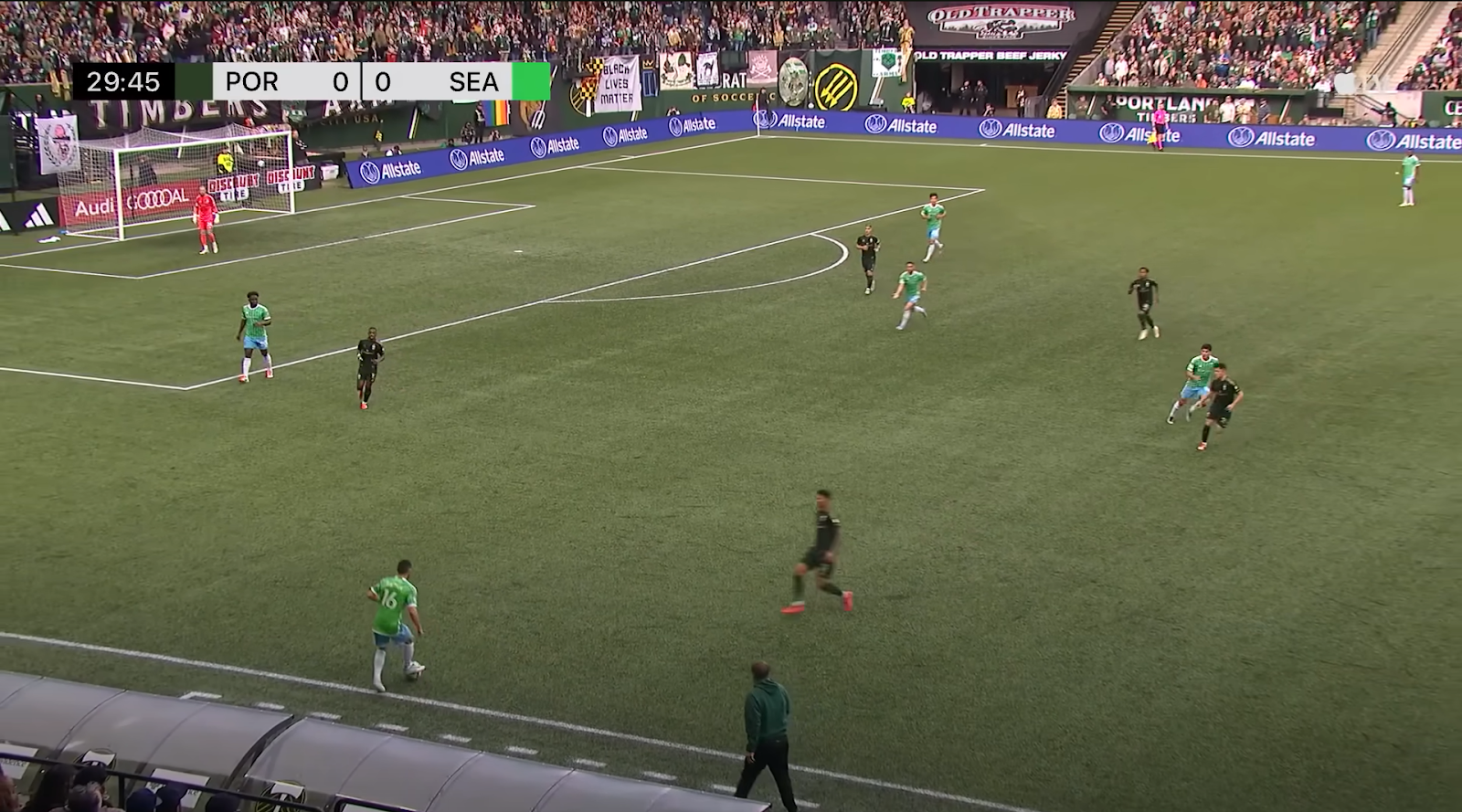
That “light pressure” (rather generous with that choice of phrase) forces Yeimar to pass the ball to Alex Roldan on the right touchline. I’m going to point out something immediately: Portland is obviously engaging in a man-marking scheme. Antony is now charged with pressuring the lesser Roldan. Ayala is marking Obed Vargas, and Joao Ortiz’s man is Cristian Roldan.
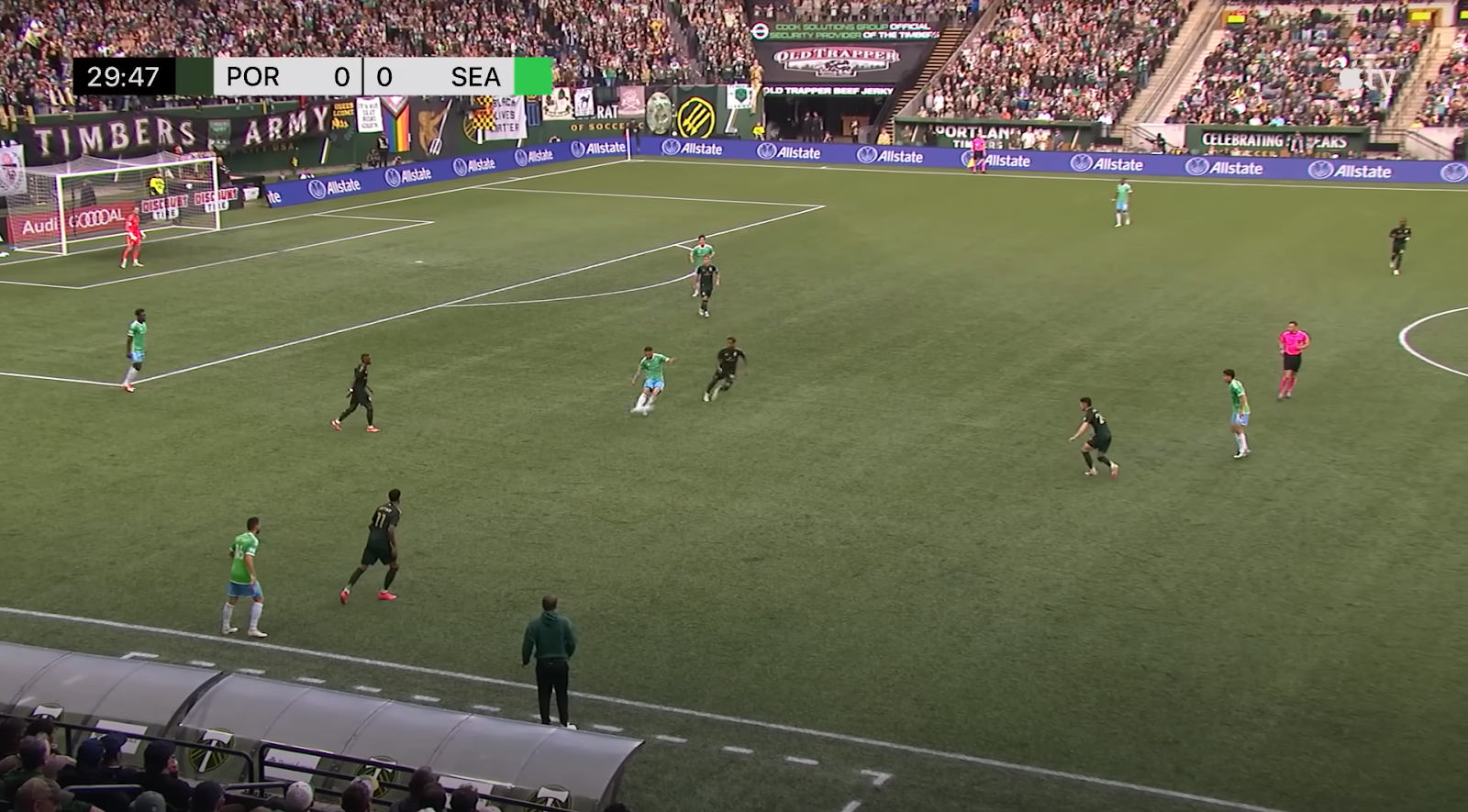
Antony is a half-second too late to block this pass from brother to brother. Ortiz is a half-second too late to get to his marker. Cristian, to be fair, is a very good soccer player and an eternal pain in the ass. This play illustrates both to a very high degree.
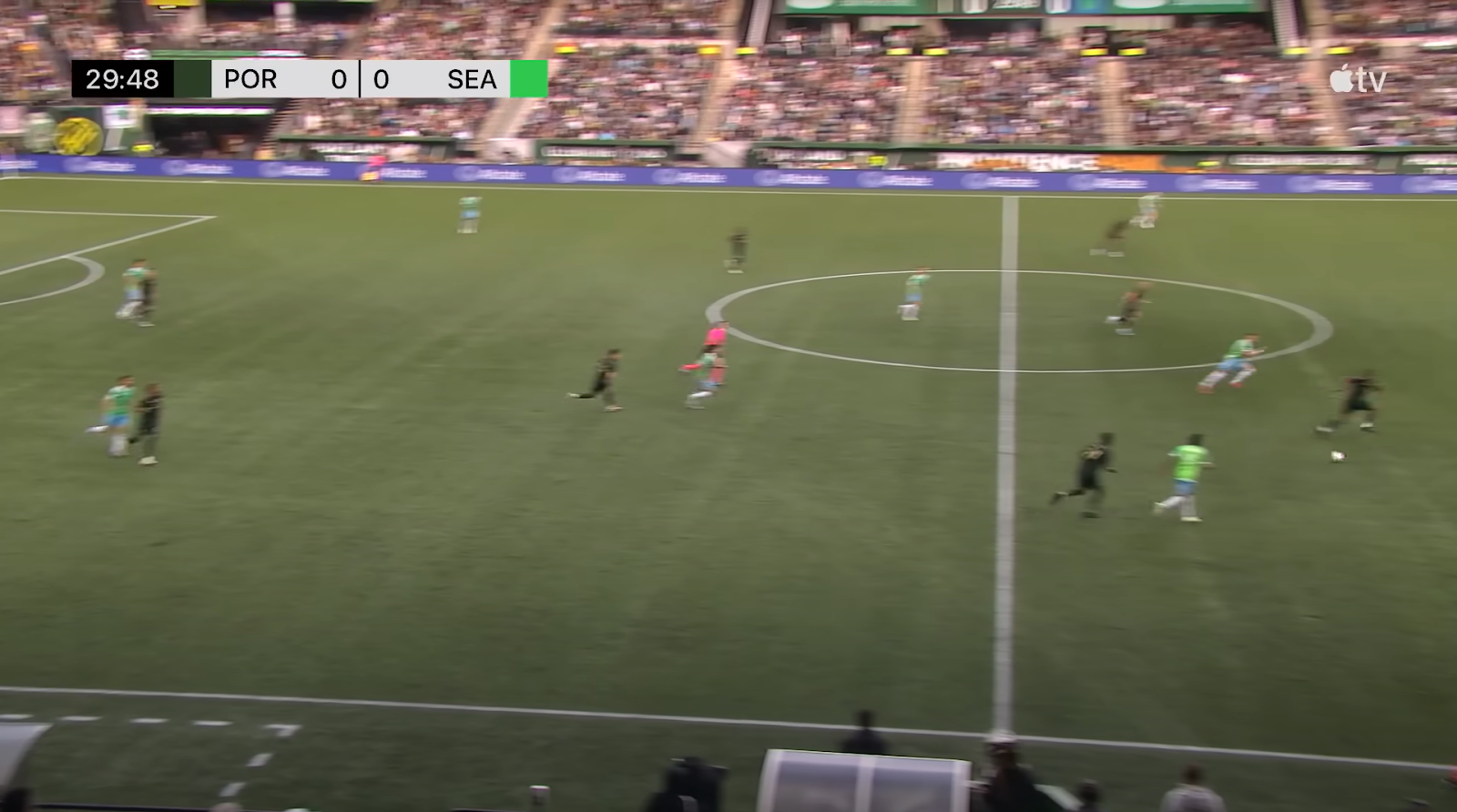
Even though there is no shot taken in this frame, it’s the most important one of the entire sequence. Look at all the space between Portland’s lines of confrontation. Roldan had the option to keep the ball and carry it through the center of the park, or another player (likely Rusnak, who’s standing in the center circle) could’ve dropped deeper to provide an outlet. But Roldan opts to take the ballsy route: a direct laser right through Portland’s midfield and into space behind the backline. Kamal Miller has reacted in time. Danny Musovski has also reacted in time. Now it’s a footrace.
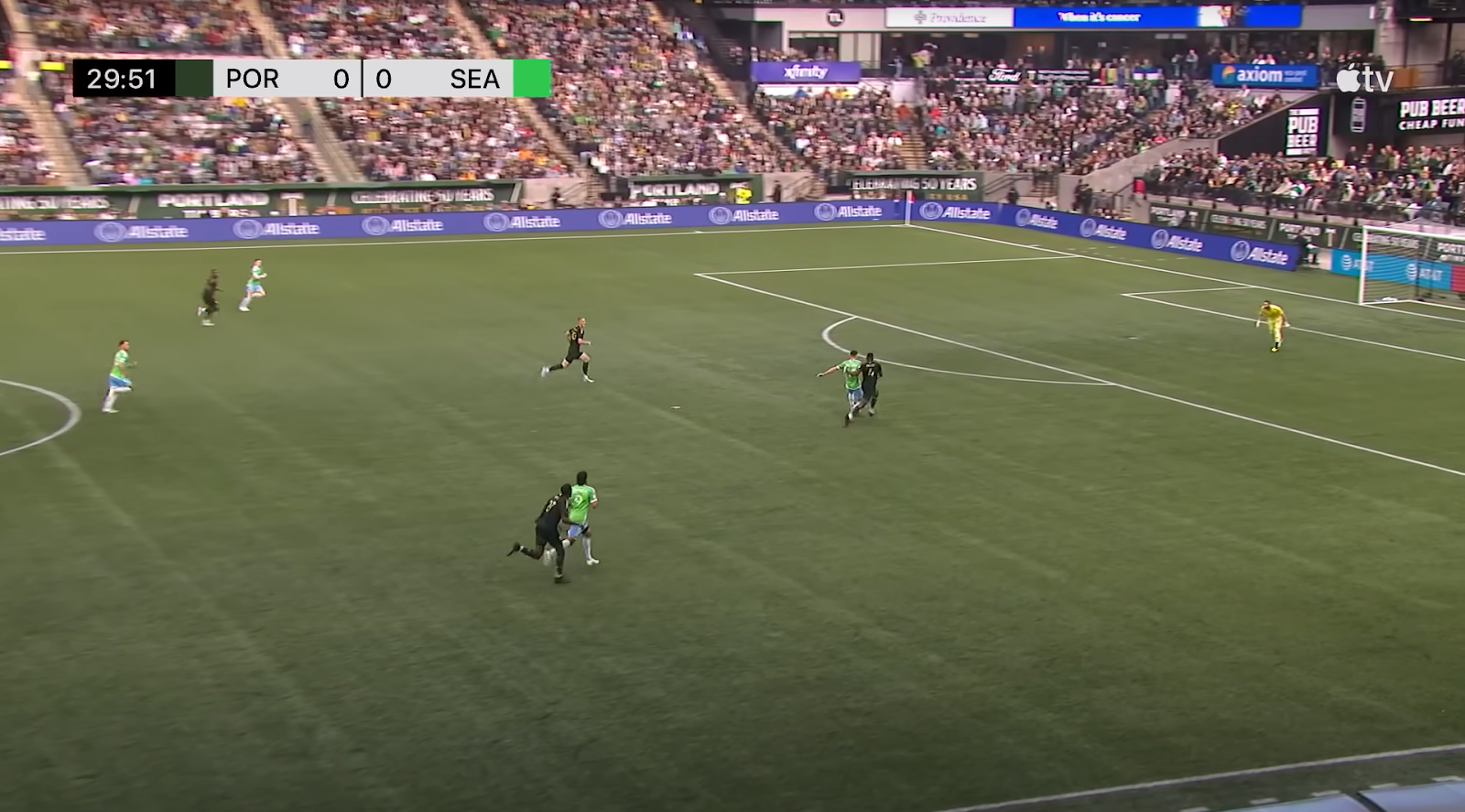
Musovski wins the footrace. There are several reasons why. The pass is the primary reason. It’s hit with an unbelievable amount of pace and it curves directly between Miller and Fory and right into Musovski’s path. This allows Musovski to take a more direct route to the ball, while Miller has to curve his run. Miller isn’t fast enough to make up the differences between the two paths to the ball, but he is able to arrive in time to get body-to-body with Musovski. Surman is arriving in support, because there’s a clear path to goal for the Seattle striker. No one is looking at Rusnak. He hasn’t made himself a threat yet.

Miller does some excellent work to get goal-side of Musovski. Surman is in a tough spot, but two recovery defenders (Mosquera and Fory) are arriving on the flanks. All Miller has to do is either win the ball or keep Musovski in front of him.

Musovski gets enough time to pass the ball backwards to Rusnak. You might notice that there are no recovery runs from midfield. That’s a problem. But now the sides are even: 4v4.
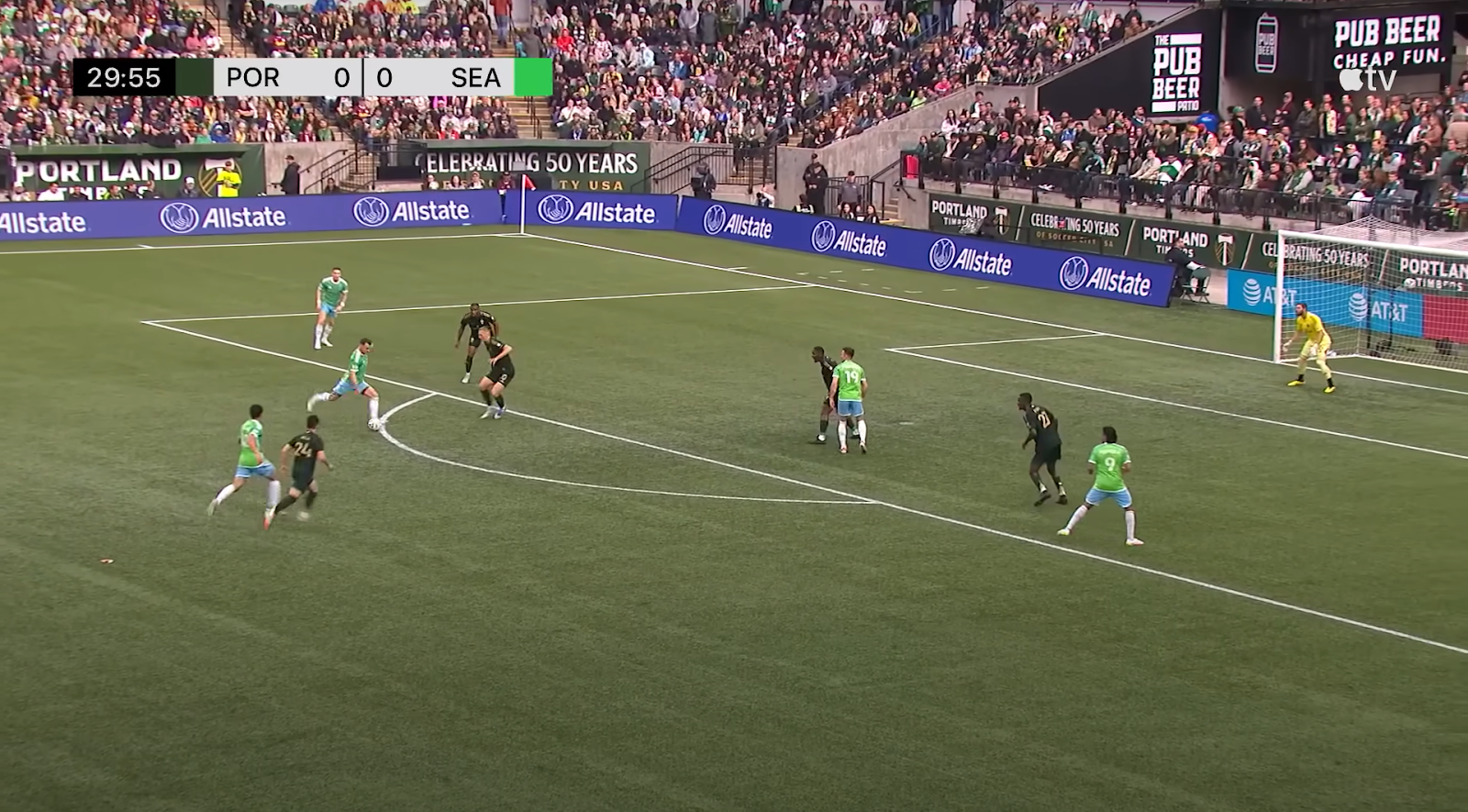
Now the recovery run arrives, but only because Vargas has decided to join in support. This is the chance that Rusnak has. In theory, this is a pretty good example of Portland’s transition defense. Good recovery runs, and Seattle has to settle for a chance of lesser value. But this is Albert Rusnak, and this is still a decent chance.
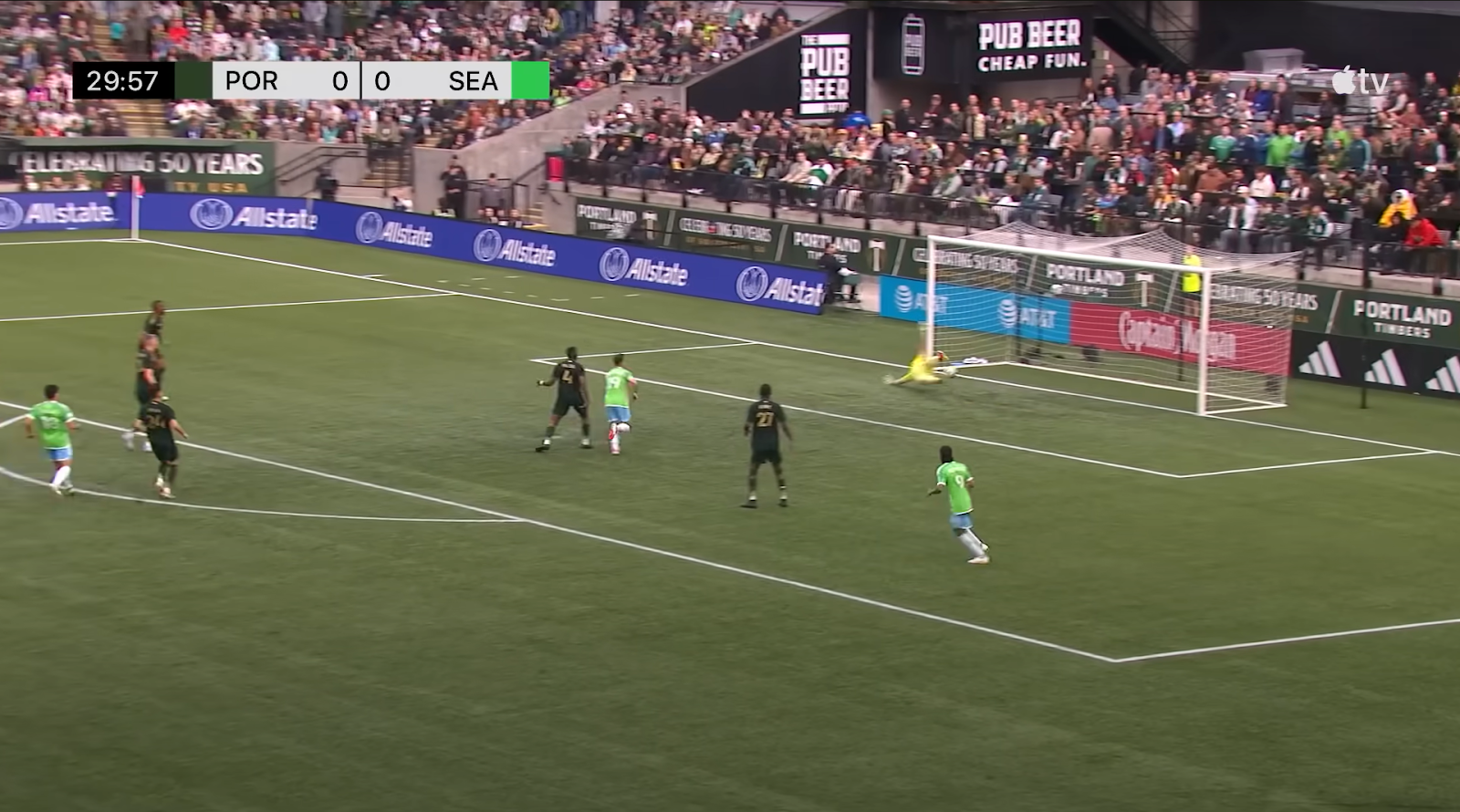
Case and point. Crepeau begins the sequence at his near post, but Rusnak is able to fool him with each of the touches he takes before the shot. In that time, Crepeau remains in his spot. Rusnak, however, is going for that near post. Crepeau believes that he’s forced Rusnak to go to the less-guarded far post, but Rusnak is dead-set on where he wants to go. Surman doesn’t stick a foot out, and Crepeau takes a half-step of hesitation to the far post right after the shot is struck. As a result, Crepeau is a half-second behind the shot and it sneaks by him.
This brings up the question of who is to blame. Is it Portland’s scheme for allowing too much space in Seattle’s half? Is it Surman for failing to close down the shot? Is it Crepeau’s fault that his perfectly logical scheme failed? Or is this a very good goal scored by a good team? Roldan’s pass is otherworldly, and Rusnak makes a DP-level play. I’ll have the answer later. Time to look at goal number two: Evander’s revenge.
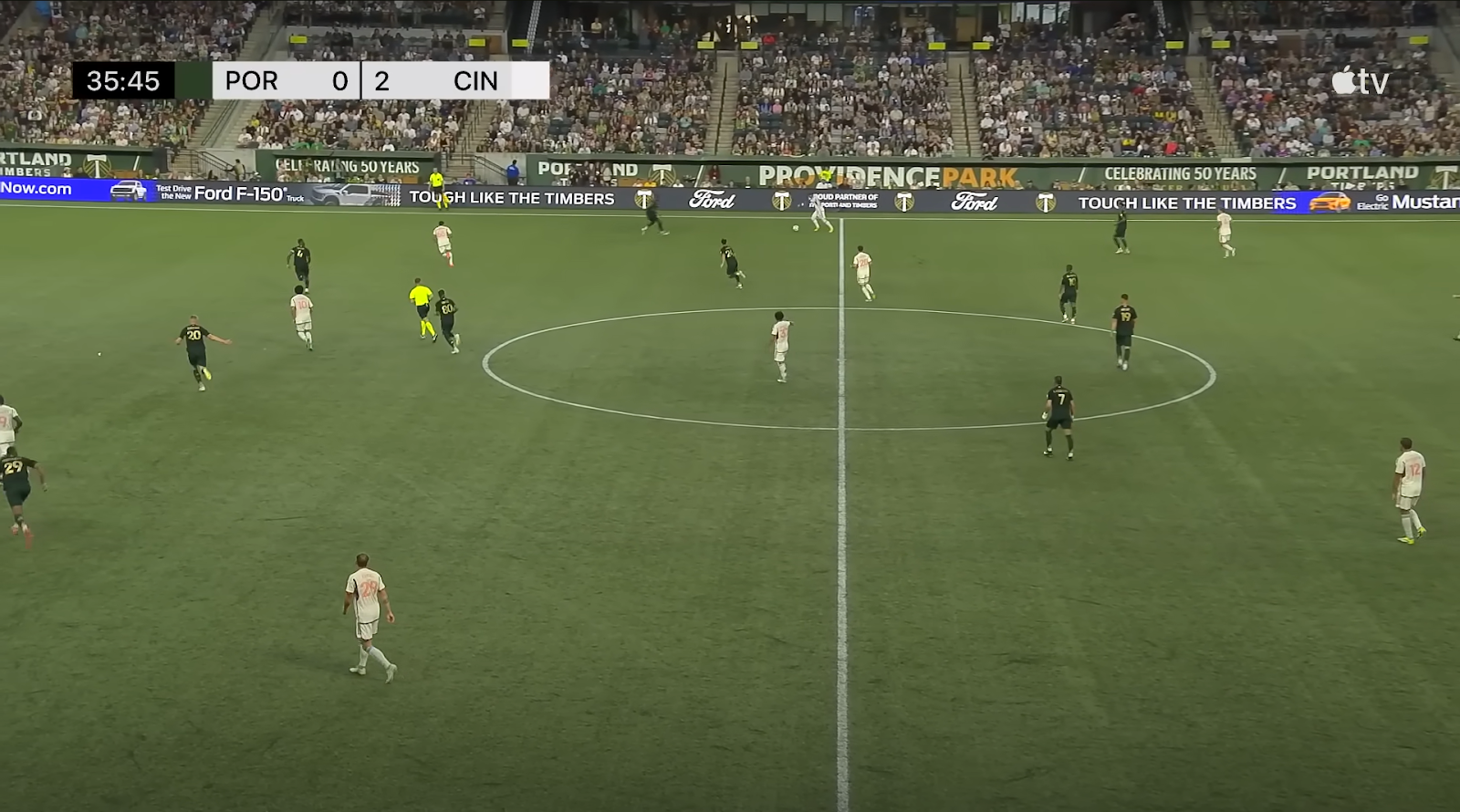
Once again, the entire sequence needs to be analyzed. DeAndre Yedlin has the ball on the right, and Fory has stepped out to mark him. This doesn’t immediately spell disaster, but it’s worth noting that four Timbers are behind the ball.
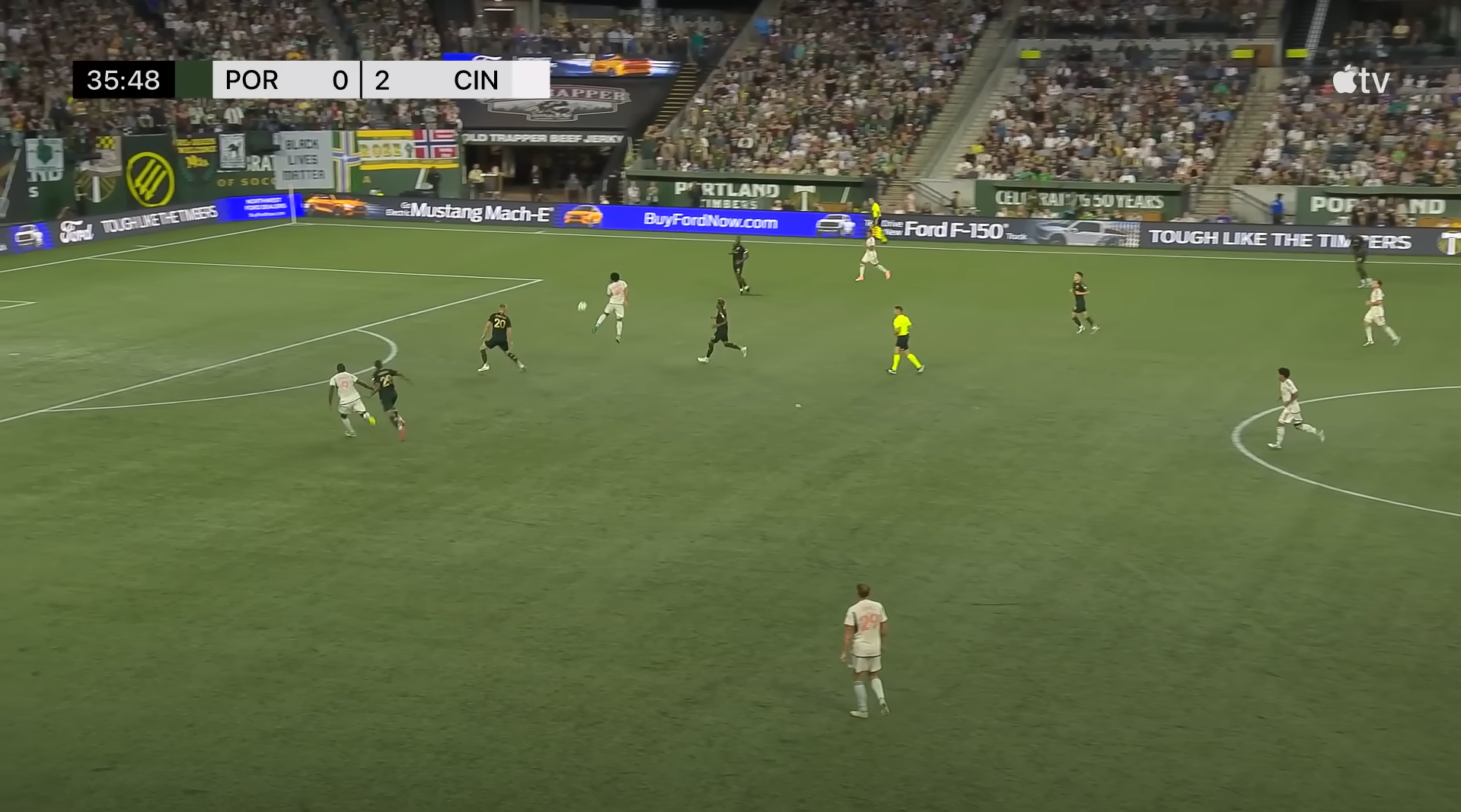
Yedlin chooses to play a diagonal entry ball towards Evander. To meet the ball, Evander jumps and is hoping to flick it on to Kevin Denkey. In the previous photo, Denkey was inside of Mosquera. Evander recognized that and hoped that Denkey was able to stay inside and be in a position to receive this flick in a dangerous position.
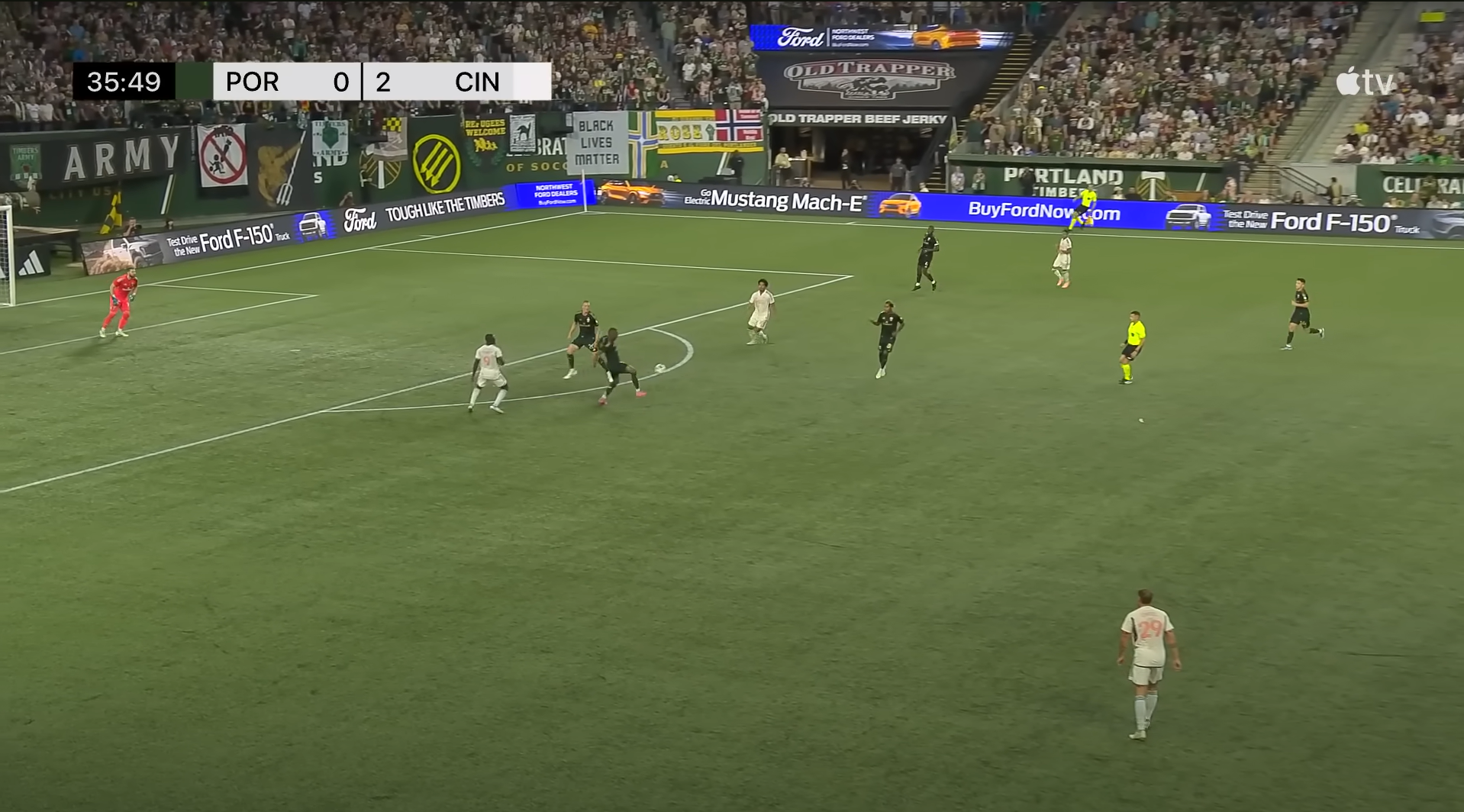
As the previous picture shows, Mosquera was able to get in front of Denkey, and now he’s made the interception. This is really good positional awareness from Mosquera. With the ball at his feet and no immediate pressure, he has a decision to make. Ortiz represents a short option, and Ayala is farther down the field. Both of these passing options are fine, but there’s also acres of space in front of him to dribble into.

Mosquera chooses Ayala. In an odd bit of symmetry, this image is somewhat similar to the still of Roldan’s stunning pass in the previous breakdown. However, there are two major differences. Ayala isn’t right-footed, and both of Cincy’s midfielders are closing down the space.
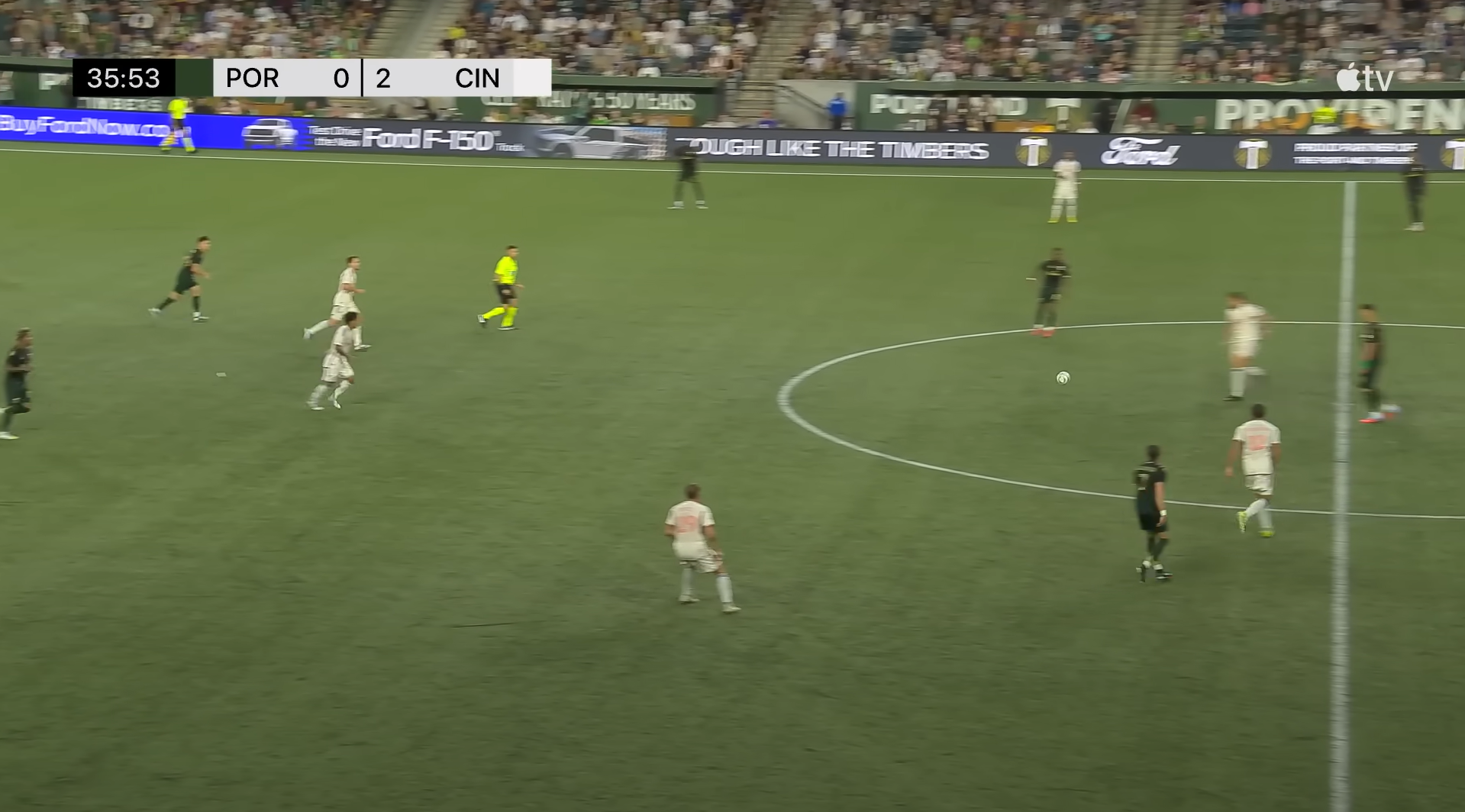
This pass is hit to where Kevin Kelsy should be. But he’s not. It’s not a clearance in the slightest. Kelsy was late to get back onsides, which allows Matt Miazga to make the easiest interception of his life.
I’ve broken down the rest of this play already. Simply put, the Timbers were not prepared for this turnover. Hell, they weren’t even prepared for the pass that led to the turnover. But Cincy can teach the Timbers a few things. We’ll get to those later.
2024 Problem 4: Defensive Cohesion
The Timbers used 20 defensive combinations in 37 competitive matches last year. Let’s see where they’re at through 32 games in 2025.
MC-A-FS-ZMG-KM-JF (#1): 1
JP-A-FS-ZMG-IS-JF (#2): 2
JP-EM-FS-KM-JF (#3): 2
JP-JDM-FS-KM-JF (#4): 4
JP-JDM-FS-KM-IS (#5): 1
MC-JDM-FS-KM-CB (#6): 2
MC-EM-ZMG-DZ-CB (#7): 1
MC-JDM-DZ-KM-CB (#8): 1
MC-JDM-FS-KM-JF (#9): 3
MC-EM-DZ-FS-KM-CB (#10): 1
MC-JDM-FS-DZ-JF (#11): 3
JP-JDM-DZ-KM-JF (#12): 1
JP-JDM-FS-DZ-JF (#13): 4
MC-JDM-DZ-FS-KM-IS (#14): 1
MC-JDM-DZ-FS-KM-JF (#15): 1
MC-JDM-FS-KM-JF-IS (#16): 1
JP-JDM-JF-KM-FS-IS (#17): 1
JP-EM-DZ-ZMG-KM-IS (#18): 1
MC-JDM-FS-DZ-JF-IS (#19): 1
MC-JDM-FS-DZ-KM-IS (#20): 1
Ladies and gentlemen, the Timbers have already matched their total backline combinations from 2024. There are multiple reasons why.
Let’s begin with the consistent goalkeeper competition. Pantemis and Crepeau have each missed time due to injury, but Neville hasn’t been able to settle on the primary starter when both are healthy. Several of these combinations feature the same defenders but different goalkeepers. Although Pantemis has started each of the last two games, I doubt that the competition has been completely settled.
The sheer amount of different competitions is another factor. Between Open Cup, Leagues Cup, and regular MLS matches, Portland has played 7 midweek matches. 14 of their 32 games have taken place on short rest. 2 of their final 6 games will also be affected by short rest. Despite losing Claudio Bravo and Miguel Araujo, Portland’s defensive depth has remained a real strength.
Suspensions, injuries, and international duty also play a part. Zuparic missed time at the beginning of the year. McGraw’s back injury took two months to fully heal. Mosquera began the year hurt. Kamal Miller and Fory have each served yellow and red card suspensions. Crepeau and Surman had international call-ups that forced them to miss club games. These are normal ripples that a team has to deal with over the course of a season.
The injuries, in particular, were also affecting the composition of the backline. But it wasn’t because the defenders were injured. 12 of Portland’s 32 games featured a back three/five. Because attackers kept missing time, Neville had to change the team’s structure. However, the team was able to continue using the same principles in either formation.
Despite the numerous combinations, there is a single constant: Finn Surman. The Timbers have only played 4 games without their stalwart Kiwi. 3 of those were rotation-based, and 1 was due to international duty. Fory has started the majority of games that he’s been available for, and so has Mosquera. The final spot that needs to be nailed down (besides goalkeeper) is Surman’s partner for the rest of the season. Both Miller and Zuparic have shown promise in that role, but have also been mistake-prone. With only six games left, Neville has to solidify his first-choice defensive unit.
Last season, he continued rotating center backs and goalkeepers during the final stretch of the season. However, if the Timbers want to cruise into the postseason and possibly beyond, there are still a few problems to fix.
The New To-Do List
A New Out-Of-Possession Structure
You’d expect me to lead off with a simple statement: score more goals. This is correct, but Portland’s recent playoff runs have featured a strong defense. Using NPxGA per 90, Portland’s defense is right on par with last season (1.33 NPxGA/90 in both campaigns). However, the 2025 Timbers have already surpassed 2024’s tally of 6 clean sheets (7 this year). But with weaknesses still present, Portland still needs to make some changes. I’ve been alluding to it for a while; across multiple articles and several hints throughout this piece. Finally, the forum exists for the deep breakdown of the Timbers’ biggest defensive weakness: their out-of-possession structure.
Let’s begin with the 4-2-3-1 since the Timbers will probably be using it for the remainder of the season.
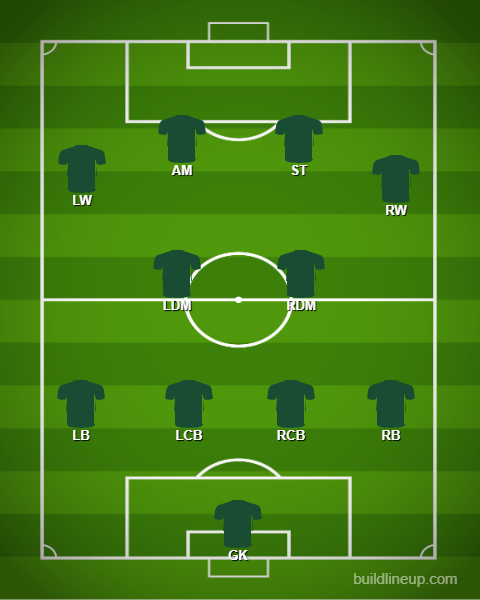
Because this formation builder has gigantic icons, the main issue isn’t apparent from the graphic alone. On paper, this is a solid structure. Portland’s man-marking system isn’t unique to the Timbers; several top clubs around the world employ the same out-of-possession principle. But the Timbers have a problem that those teams don’t share. When Portland sets up to defend high up the pitch, they’re stuck between a mid-block and a high press.
The first line of confrontation is drawn by the front four. The attacking midfielder and the striker form the center, with the wingers pushing high to mark the opposing fullbacks. This doesn’t seem so bad on the surface. In theory, this high line of confrontation forces the opposition to play long balls. But the main problem forms in the second line.
With only two midfielders tasked with covering an unbelievable amount of space, it becomes far too easy for opposing midfielders to make runs, lose their markers, and receive passes directly through the center of the pitch. That’s the area teams do not want the ball progressed through. Yet the Timbers, almost by design, are giving them that space freely. Portland’s entire first line can be taken out of the play by a single pass. This happens far too often. When the Timbers give the opposition so much space in the middle of the pitch, opposition attacks can be sprung with the speed of a finger snap.
And they often do! Through decent, non-revolutionary off-ball movements, opposing teams are able to pass the ball through and around Portland’s defense. Once they get to the box, it becomes harder, but Portland’s midfield still feels like Swiss cheese at times. The Timbers have only won 4.93 tackles in the middle third per 90. That’s the second-lowest in the league. Because both central midfielders have to cover so much ground, it puts Portland at a disadvantage to win the ball back at the Timbers’ most advantageous area on the pitch to do so.
If the Timbers can consistently win the ball back in the middle of the pitch, they have enough space to quickly counter and use their biggest strength: speed. It becomes another case of the defense fixing the offense. So how do they solve it?
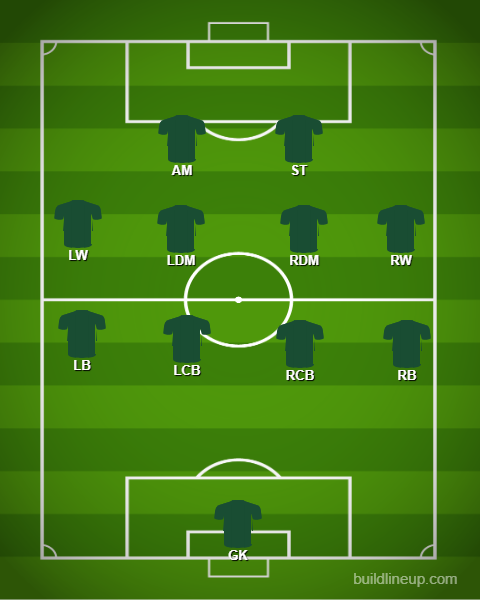
Since the 4-2-3-1 is here to stay for the rest of the season, the Timbers need to put their focus into winning the ball back in the middle of the pitch. In order to do so, the two wide forwards could drop back to the second line. But I have to be honest here: I like the idea of at least three players in the first line. How else can this be fixed?
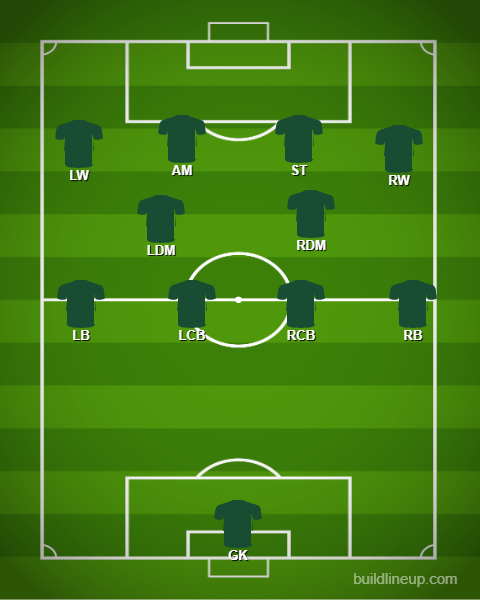
This is what the Timbers do in desperation time. They strangle teams in their own half. If they started doing this from the opening whistle, they’d become a much more difficult side to play against. By pushing their entire team into the opposition half, the midfield gaps become less dramatic. This is a structural press. Turnovers can occur out wide and in the middle. But a structure alone cannot help the Timbers suffocate their opponents.
Counterpressing
Portland’s broken off-ball structure can be illustrated by one particular advanced stat as well as the eye test. When watching a Timbers game, it’s very easy to witness how easy it is for opposing players to carry the ball. According to American Soccer Analysis’ Goals Added metric, the Timbers have the 9th-worst number for dribbling G+ against. However, they have the 9th-best number for passing G+ against. Teams are finding success against the Timbers by carrying the ball. The solution? Become more aggressive.
With the improved off-ball structure, the Timbers will be in better positions to make tackles. Their defending is rather passive, but there are some interesting stats that support a move to a more high-energy pressing team. They currently have the 10th-most tackles in the attacking 3rd. That’s pretty impressive considering the Timbers do not have an organized counterpress.
This is the secret sauce that Portland has been missing off-the-ball. Nothing is more fearsome than a well-organized counterpress. Once again, it begins to appear when the Timbers are already in desperation mode. The second half in Orlando is an excellent example of it, but none of Portland’s attacking moves resulted in a goal.
If they begin games on the front foot and force the game to be played in the opposition half, goals will come and they will cement themselves as a tough team to beat. Particularly at home, where they haven’t won a MLS game since July 5th (3-match winless streak). Success in the playoffs is dictated by being a tough team to beat. This is the next step in Portland’s evolution. Killer mentality off the ball with a structure to support it goes a long way.
In addition, this would also help the Timbers defend the long ball. While many have observed Portland’s troubles (particularly in the early stages of the season) with defending balls over the top, my main concern is about the second ball. As the season has progressed, the Timbers have gotten better at defending these types of plays. Some of that is down to personnel more than tactics. But the counterpress mentality can also help the Timbers defend the long ball AND recover second balls. Let’s go back to the last goal that Portland conceded for a brief moment.
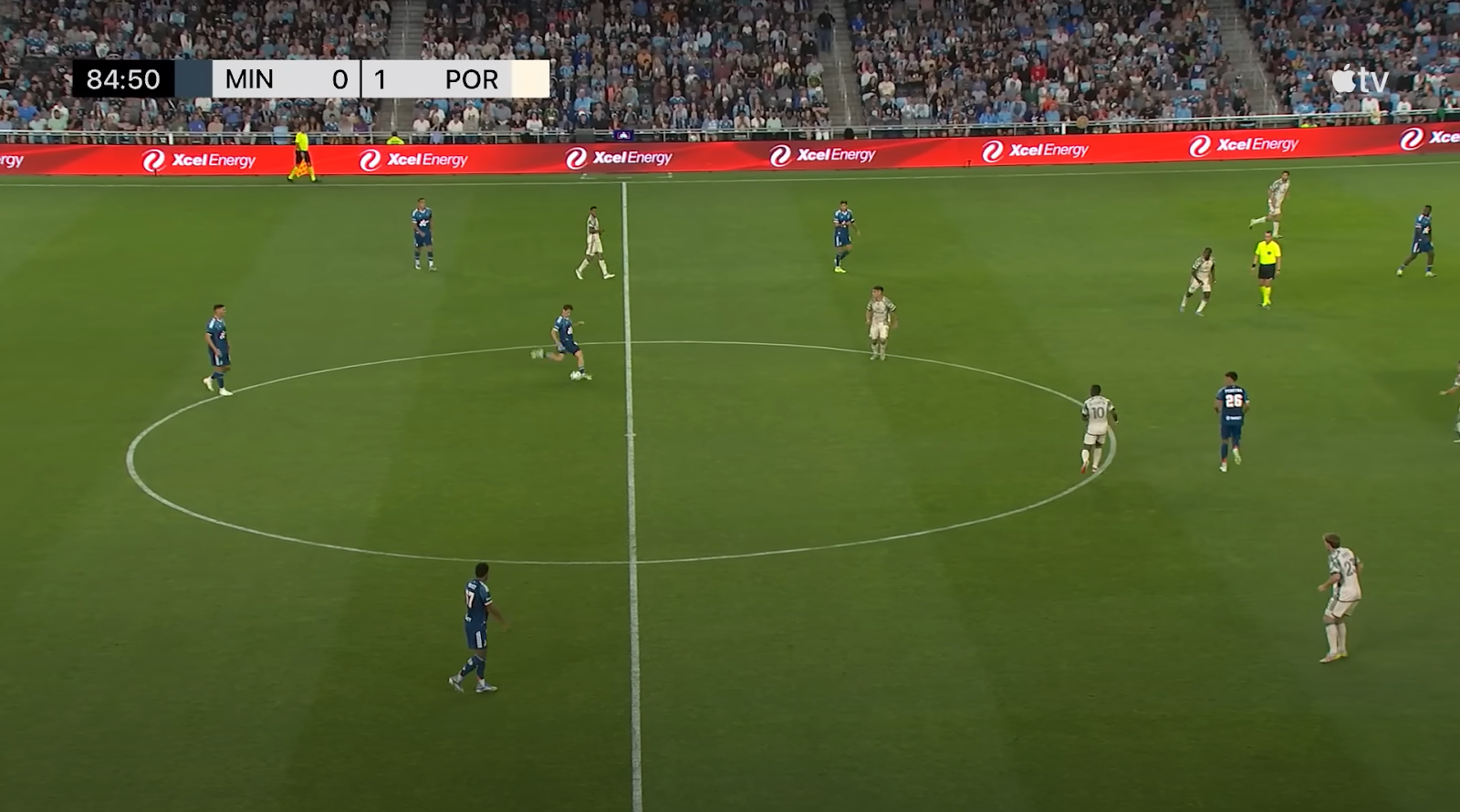
I’d qualify this as good attacking more than a defensive lapse after watching this goal several times. But what bugs me the most is how much space Wil Trapp has to pick exactly where he wants this ball to go. The run is disguised, but this pass should’ve been stopped. No one steps to him. That’s where the main error comes from. Not Zuparic or Fory, but allowing this pass to be made without any attempt to stop it.
Portland’s aerial duel win rate (52.4%, 8th-highest in the league and 3rd-highest in the Western Conference) usually works in their favor when they’re trying to defend the long ball. The offside trap has also been a good tool to have. But their ability to vacuum up the second balls from those won headers is the bigger issue. The proposed pressing structure would keep the lines closer together and give the Timbers a better chance to win those second balls. Positioning combined with effort would allow Portland to win these balls and spring attacks.
Off-Ball Runs
With the counterpress sorted out, now the focus turns to what happens when the Timbers win the ball back. Portland’s attack has taken a serious step back from last year (1.48 NPxG per 90 in 2024 compared to 1.12 in 2025). A variety of obvious reasons (injuries, one consistently healthy attacking DP, injuries again) have combined to tank Portland’s attack. That 1.12 number I just mentioned? That’s the 5th-worst in the league, and the lowest of any playoff team (Cincinnati is just ahead of them at 1.14). Three major additions came in during the summer window, and they’re all tasked with helping the team score more goals. While personnel can certainly help, one other tactical aspect is desperately needed: dangerous off-ball runs.
Let’s begin this section with a David Da Costa stat. Per Opta, 21 of Da Costa’s carries have ended in a chance. That’s 5th-most in the league, behind stars like Carles Gil, Anders Dreyer, and Cristian Espinoza (Theo Corbeanu is the 4th player). However, the next stat jumps off the page: 5 of those carries have ended in an assist, which is second-most in the league behind Dreyer.
Da Costa’s 2025 season has gone under the radar. As the lone DP in his first season, there’s an abnormal amount of weight on his shoulders to keep the attack humming. But he hasn’t been getting the right amount of help from his fellow attackers. Particularly when it comes to off-ball runs.
Neville’s primary attacking tactic is predicated on sending crosses into the box from wide areas. And no other area of the pitch gets more use than the left wing. Per WhoScored, Portland attacks down the left 40% of the time. That’s the 3rd-most in the league. 25% of their shots are from the left, which is the most in the league. When it comes to the center of the pitch, the Timbers take 62% of their shots. That constitutes the 3rd-lowest percentage in the league. That’s the most dangerous area of the pitch, and the Timbers aren’t shooting from it. Here’s how to solve that.
Taking more shots from distance will help, but I’d like to talk about Portland’s play around the box. The Timbers do not employ a lot of slip passes to players running in behind. These short through balls open up the box and create space for players to crash the center of the box to receive a cross. It changes the type of delivery from a cross to a cutback, which is much more dangerous. These simple runs are desperately needed in Portland’s attacking arsenal. And Da Costa’s carries can unlock them.
When Da Costa joined Portland, I was more convinced that he’d be a “pass-before-the-pass” guy than a true creator. This proposed emphasis on slip passes and cutbacks allows him to be the true pass-before-the-pass guy and then crash the box. As it stands, Portland is far too easy to defend. These adjustments will help them score more goals.
The presence of Kristoffer Velde in particular can also help. Despite an excellent showing as the number 10 against Minnesota, I still believe his permanent home is on the right wing with Antony on the left. However, Portland’s front three can all play out wide and through the middle. This might seem weird considering Antony is a pure winger, but on counterattacks he provides a mismatch if he’s running the channels. Velde can be effective anywhere, while Da Costa’s primary strength (ball-carrying) can be utilized out wide or in the center of the pitch. All that matters is having a striker who will stay up top.
This is where Kevin Kelsy and Felipe Mora come into play. Let’s begin with the veteran Chilean first. Mora’s league scoring drought (SIXTEEN MLS GAMES WITHOUT A GOAL) needs to end. This barren spell has directly coincided with Portland’s inability to threaten the box. Mora’s superpower is the ability to put himself into great places to score goals. Last year, he had Evander (an elite chance-creator who offers enough scoring threat to draw defenders to him). Jonathan Rodriguez’s goal threat also opened space in opposition backlines. Mora hasn’t had the same quality of players around him this year; from both chance-creation and gravity standpoints. No one is going out of their way to try to erase Antony or Da Costa from a game. And neither of those players match the profiles that the Timbers lost with Evander’s sale and Rodriguez’s injury. Velde could replace one of them (after two games, it’s unclear which one (from a gravity standpoint, of course)) but the main creator hasn’t developed the same level of chemistry with Mora that Evander had. Antony’s creative abilities are still developing. But Mora is important because he can also be a pass-before-the-pass guy. Usually, these passes are attempted in the middle third and open space farther down the field. Mora should be able to find more chances with the additions of Velde, Rojas, and Carballo. But he also needs to finish them.
Kelsy has been caught between two worlds: the playmaker and the finisher. His strengths (and his physical profile) are different than Mora’s. Kelsy has been outperforming his expected goals with several audacious finishes (SKC, Cincinnati, LA Galaxy) but has also been on hand to tap in a couple (both Colorado games). But he’s often found himself in the wrong places for those high-percentage chances due to his tendency to drop deeper and help with buildup. As a certified big boy, he’s getting better at hold-up play. This is what he should be doing. By acting as the focal point instead of another fluid forward, he can play to his strengths with the team. The best strikers in the world can flourish while only touching the ball 10-15 times in a game. Where those touches are located is the most important part. He needs to be getting those touches in the box and around the center circle. Although he wants to dribble, those extra touches can kill attacks. Kelsy needs to focus on holding up play and getting on the end of the final ball. Positionally, he needs to be occupying opposing center backs for the entirety of the time he’s on the pitch. If Kelsy is deployed like a true number 9, it opens up space for the second line underneath him. That’s a positive for the entire team, and it will lead to more goals for the young Venezuelan.
Final Whistle
It might seem odd that so much of this article is focused on defense while the attack hasn’t been able to consistently score since the early months of the season. There’s a reason for that.
The early season run that saw the Timbers rise as high as second in the West is what’s keeping them in the playoff positions. Their defense has been keeping them somewhat afloat in the summer as the goals dried up. Soccer works with the defense being the floor and the attack being the ceiling. A team that can defend well will always have a chance, but a bad defense will get trampled weekly. Good defense can always offset a struggling attack, especially in the playoffs.
In 2025, the floor has been raised. Instead of having to outscore opponents 3-2 or 4-3 to win games, the Timbers can win games by a score of 1-0 or 2-1. With the new reinforcements, Portland’s attack is set to rebound depending on how quickly the arrivals are able to integrate. While the new players gel, the defense needs to keep evolving. Because the early returns of a potential playoff run are rather encouraging.
The Timbers have played 13 games against the other playoff teams in the West. Their record in those games is 4-7-2. That’s not an amazing record, but let’s take a look at those two losses. The first is the season opener against Vancouver where the Timbers went down a man 10 minutes into the game with a ton of players making their MLS debuts. The second loss is the catastrophe in San Jose where the Timbers got absolutely knifed by the best attack (per underlying numbers) in the league. It’s worth noting that those losses are evenly split between home and away.
Portland can hang with other playoff teams. In the postseason, each draw represents a potential penalty shootout. But the Timbers have added the attacking quality to increase their goalscoring with the suggested tactical tweaks. The defense will determine how far they can advance in the playoffs. Against other playoff teams, the Timbers are tough to beat. But they could be tougher to beat if they keep evolving. Failures to beat teams lower in the table than them is what has kept the Timbers treading water instead of rising into the top four.
The 2025 Timbers will make the playoffs. I’m 100% confident of that. They have enough quality and solidity to avoid the play-in game, despite the current table situation.
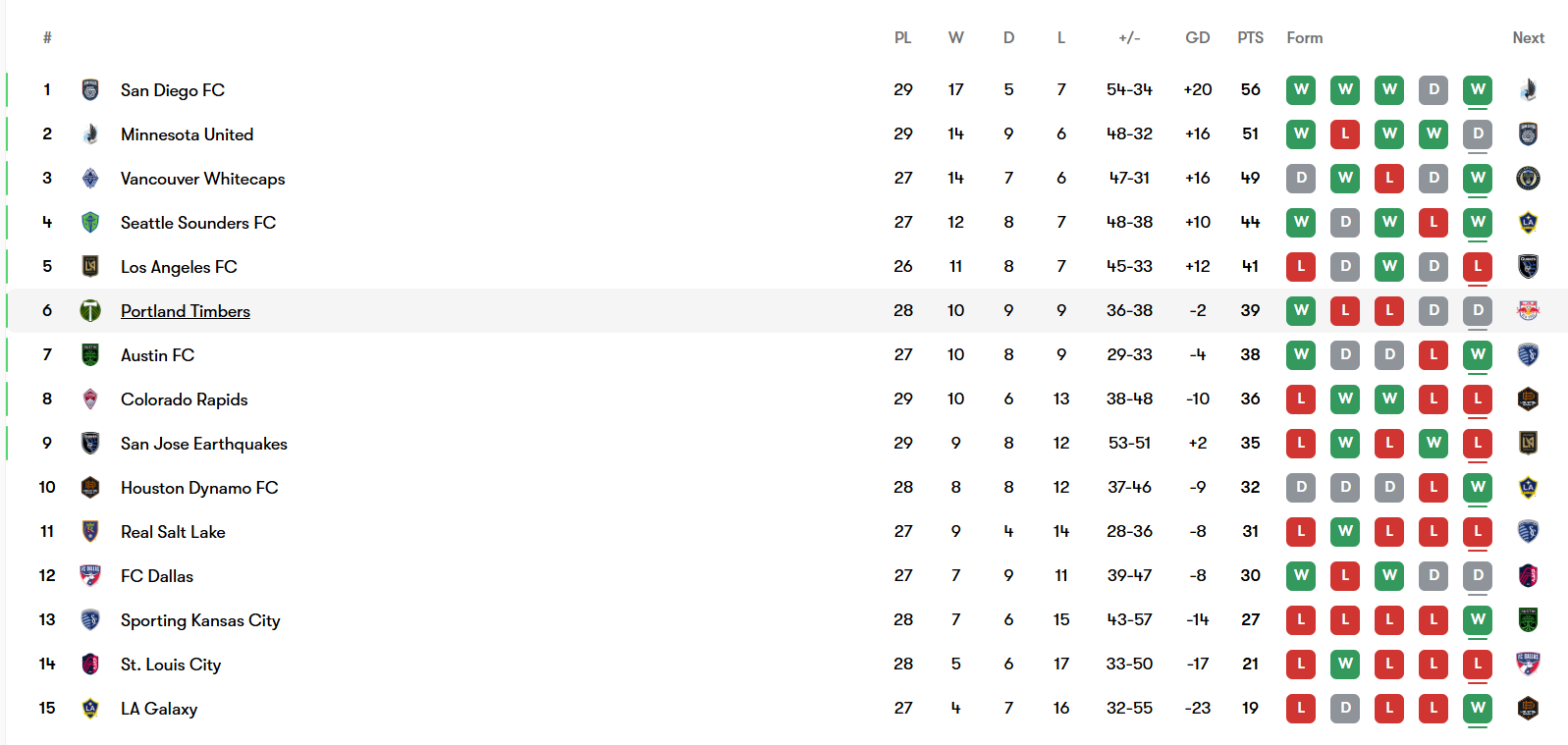
What matters is the preparation for the playoffs. Luckily, their remaining schedule is a pretty good proving ground.
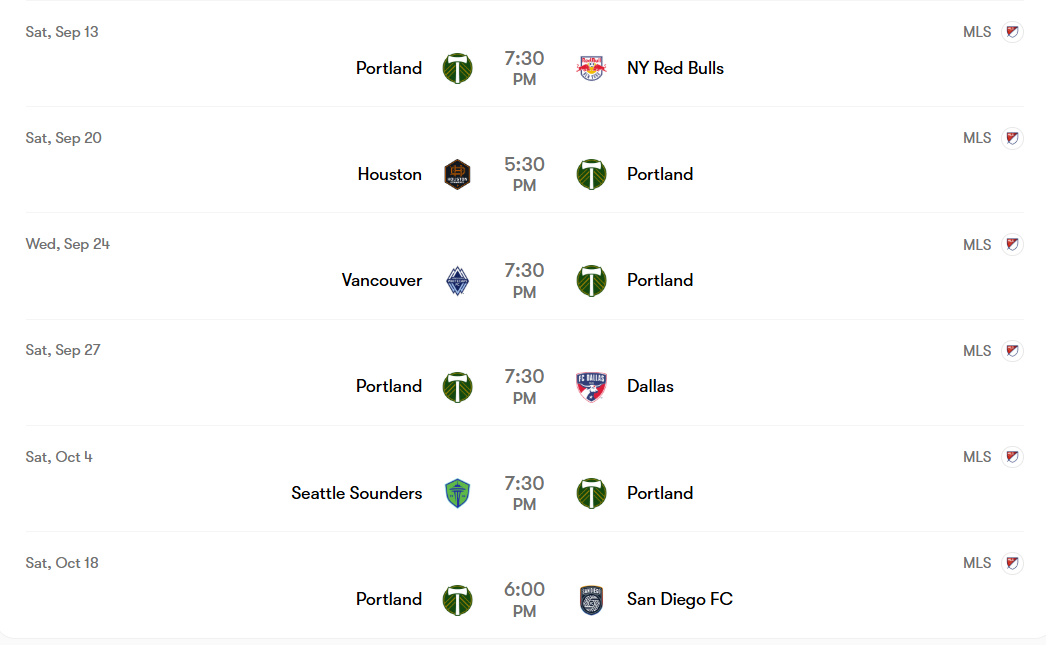
Four of these teams are currently in the playoff places. Three of them are above the Timbers in the Western Conference. One of them is a perennial thorn in Portland’s side, especially on the road. The final one is at the end of a 3-match week that features two road games. This is not an easy schedule. But it is the perfect way to prepare the Timbers for the postseason. As the rest of the Western Conference keeps cannibalizing each other, Portland can keep climbing. But it will be a hard task, and the team is nowhere near the complete sum of its parts. For the rest of 2025 and into the future, the evolution needs to start. The climb continues.

